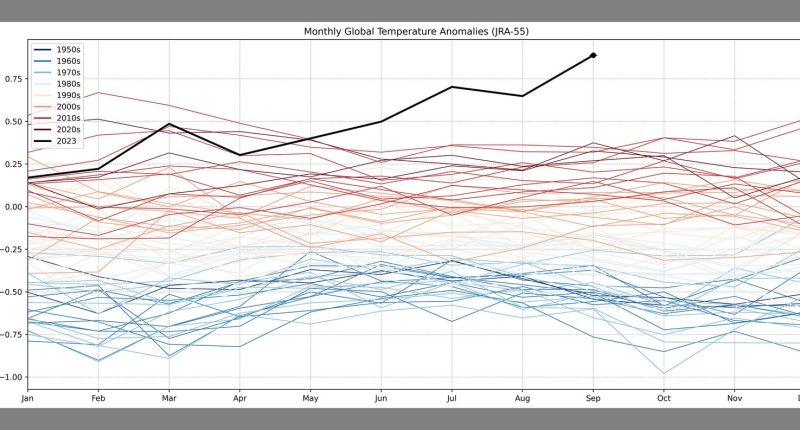
The global temperature numbers for September are in, and they are not good. “This month was, in my professional opinion as a climate scientist—absolutely gobsmackingly bananas,” Zeke Hausfather posted Tuesday on X (formerly known as Twitter).
Kristina Dahl, principal climate scientist at the Union of Concerned Scientists, read that post yesterday. “I’ve been sitting at my desk trying to think of a better way to describe that, but I can’t,” Dahl says. “It’s just shocking.”
“Concerning, worrying, wild—whatever superlative you want to use,” says Kate Marvel, senior scientist at Project Drawdown, a nonprofit that fights climate change. “That’s what it is.”
The graph below, created by Hausfather, a researcher at the climate group Berkeley Earth, shows temperature anomalies, meaning how high each month was above a historical average baseline temperature. Each multicolored line represents a previous year, color coded by decade. (The 1990s, for example, are the lines in yellow.) The solid black line is 2023, and it has been soaring above the others since May. It stops in the month of September, which beat the prior monthly record by more than 0.5 degrees Celsius.
This September was on average 1.8 degrees C hotter than preindustrial levels, well above the Paris Agreement’s goal of keeping temperatures from rising more than 1.5 C. (Important caveats on that in a moment.)
Courtesy of Zeke Hausfather
“We’ve already seen a summer of extreme temperatures, so my threshold for being surprised was a bit higher,” Hausfather tells WIRED. “But just how extreme September was, it’s kind of bananas; 0.5 C is just off the charts. We’ve never seen a month with that level of jump before.”
“It’s astounding to see the previous record broken by so much,” agrees Dahl. “And astounding to see that the global temperature this September is on par with what we normally see in July—the hottest month of the year, typically. So it really just illustrates how profoundly our climate is shifting.”
What’s unfolded all summer has been a mixture of climate science factors, some of which are well understood and others that are more uncertain. It’s a certainty that the more greenhouse gases we pump into the atmosphere, the more warming we get. “We should expect not just record-breaking extremes, but record-shattering extremes,” says Marvel. “Things that break previous records by incredible margins.”








